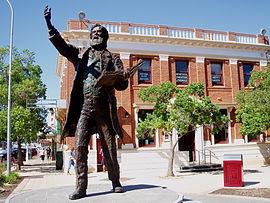Parkes, NSW
|
Parkes New South Wales |
|||||||||
|---|---|---|---|---|---|---|---|---|---|

A statue of Sir Henry Parkes, the town's namesake
|
|||||||||
| Coordinates | 33°08′0″S 148°10′0″E / 33.13333°S 148.16667°ECoordinates: 33°08′0″S 148°10′0″E / 33.13333°S 148.16667°E | ||||||||
| Population | 15,450 (30 June 2016) | ||||||||
| Established | 1873 | ||||||||
| Postcode(s) | 2870 | ||||||||
| Elevation | 324 m (1,063 ft) | ||||||||
| LGA(s) | Parkes Shire | ||||||||
| County | Ashburnham | ||||||||
| State electorate(s) | Orange | ||||||||
| Federal Division(s) | Calare | ||||||||
|
|||||||||
Parkes is a town in New South Wales, Australia. It is the main settlement in the local government area of Parkes Shire. Parkes had an urban population of 15,450 as at 30 June 2016.
Parkes was founded in 1853 as the settlement Currajong, named for the abundance of kurrajong trees in the local area by the settlers, but was then known as Bushman's (from the local mine named Bushman's Lead).
In August 1873, Henry Parkes (later Sir Henry) visited the area and in December 1873 the town was officially renamed Parkes in his honour . (Sir Henry Parkes is recognised in Australia as having played an instrumental role in Australia becoming a unified and federated country.) In March 1885, Parkes was proclaimed a town.
Bushman's Lead Post Office opened on 1 August 1872 and was renamed Parkes in 1873. The railway from Molong via Parkes to Forbes, was officially opened on 18 December 1893.
Parkes attracted significant attention during the gold rush of the 1870s onwards, and even to this day modern mining companies still have sites in the region.
In 1939, Parkes became a sister city with Coventry in the United Kingdom. This was in honour of the fact Sir Henry Parkes was born in Coventry.
With the presence of the nearby Parkes Observatory, Parkes has had an important role in the scientific community. In addition to local research conducted at the radio telescope, Parkes scientists have assisted NASA for several missions as a Southern Hemisphere relay and communications station. (The movie The Dish was based somewhat loosely on the role the telescope played during the 1969 Apollo 11 moon landing.)
A rich variety of farming is conducted in the region immediately surrounding Parkes, although the staple farming products are wheat and wool.
Parkes prides itself on its modernising ideology, historically and culturally. The Dish, although set in Parkes, was largely filmed in Forbes' historic precinct. This is due to very few historic buildings remaining in Parkes. Parkes is also home to the Parkes Spacemen rugby league club.
...
Wikipedia

